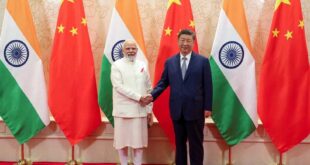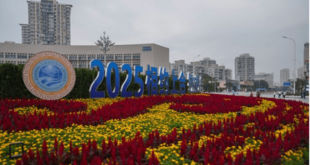The global economic landscape is undergoing a profound transformation, driven by evolving trade dynamics, technological cooperation, and the surging sustainable industries sector. As China deepens its economic ties with the European Union (EU), expanding global technological collaboration, and strengthens its role in clean energy markets—including electric vehicles (EVs), solar panels, and battery technologies—these strategic moves highlight the shifting balance of power in the global economy. The interplay between these developments is shaping a new multipolar economic order—one in which economic resilience, innovation, and sustainability define success.
The recent meeting between Chinese Vice Premier He Lifeng and European Commissioner for Trade and Economic Security, Maros Sefcovic, underscores the significance of China-EU economic relations. Marking the 50th anniversary of diplomatic ties, both sides have expressed a commitment to deepening economic cooperation, overcoming trade disputes through dialogue, and resisting the rising tide of protectionism.
China’s willingness to expand openness and engage in constructive dialogue signals a pragmatic approach to maintaining stability in global trade. For the EU, China remains an indispensable partner—offering a vast consumer market, advanced manufacturing capabilities, and a critical role in supply chains. A balanced and rules-based economic relationship between China and the EU became essential amid the current trade war with the United States.
Parallel to its economic diplomacy, China is reinforcing its role as a global leader in science and technology. At the 2025 Zhongguancun Forum Annual Conference, Chinese Vice Premier Zhang Guoqing emphasized the need for mutually beneficial and win-win global scientific and technological cooperation.
The world is currently experiencing a new wave of technological revolution and industrial transformation, driven by artificial intelligence, quantum computing, and green technologies. China’s approach to fostering innovation is deeply tied to its broader economic vision under the ‘Made in China 2025’ policy. Leveraging technological advancements to propel new quality productive forces. The country’s commitment to an innovation-driven strategy has already yielded substantial progress in integrating scientific advancements with industrial applications.
China’s emphasis on global collaboration is particularly relevant at a time when geopolitical tensions threaten to fragment the world’s technological landscape. Restrictive policies on semiconductor exports, competition over artificial intelligence dominance, and concerns over cybersecurity have led to the creation of parallel tech ecosystems. Yet, global challenges such as climate change and sustainable development require a cooperative approach. By promoting international research partnerships and open dialogue, China is positioning itself as a key player in shaping the future of global technology governance.
China was the EU’s main partner for high-tech imports in 2023, totaling over €155 billion. However, the country is banned from participating in ‘close-to-market innovation actions’ under the EU’s Horizon Europe program, which became a barrier for enhanced cooperation. Additionally, in January 2025, the European Commission filed a complaint against China at the World Trade Organization for the violation of high-tech patent royalties and breach of patent owner’s consent. These differences must be overcome to implement better cooperation mechanisms in the tech industry.
As the world accelerates toward a cleaner future, sustainable industries, including EVs, solar panels, and battery technologies, have become focal points of economic competition. China, already the world’s largest EV producer, continues to expand its global presence, not only through domestic advancements but also by investing in foreign markets. The country’s dominance in battery technology and renewable energy supply chains makes it a central player in the industry’s evolution.
China’s strategic push into international markets is evident in its growing partnerships and investments. Clean energy giants are expanding their footprint beyond China, exploring opportunities in Europe, Southeast Asia, Latin America, and beyond.
The global race for sustainable industries is intensifying, with the United States, the EU, and other nations ramping up production, offering subsidies, and securing critical raw materials to reduce reliance on Chinese supply chains. Yet, China’s head start in battery manufacturing, solar energy production, and supply chain efficiency gives it a significant advantage. The challenge for other economies lies in balancing competition with strategic collaboration—ensuring that the transition to a clean energy future is driven by innovation rather than protectionist policies.
Taken together, these developments reflect the emergence of a multipolar economic order. China’s economic diplomacy with the EU, its leadership in global technology cooperation, and its expansion in sustainable industries are part of a broader strategy to secure long-term economic resilience and technological supremacy. This year, nearly 1,000 Chinese exhibitors participated in the Hannover Messe, with potential collaboration opportunities in sustainable industrial transformation.
For the EU, balancing economic engagement with China while safeguarding its strategic interests will be critical. In the global clean energy market, competition will continue to shape industry dynamics, but cooperation on battery innovation, solar panel production, and sustainable supply chains will be equally important. Meanwhile, the United States and other major economies will need to adapt to these shifting dynamics, ensuring that competition does not escalate into economic fragmentation.
As the world navigates an era of rapid transformation, collaboration and strategic foresight will be key. Trade policies must remain open, technological advancements should be pursued through cooperative frameworks, and sustainability must be at the heart of industrial expansion. The race for global leadership in trade, technology, and clean energy is far from over—but those who embrace innovation and international cooperation will undoubtedly shape the future.
 Geostrategic Media Political Commentary, Analysis, Security, Defense
Geostrategic Media Political Commentary, Analysis, Security, Defense





